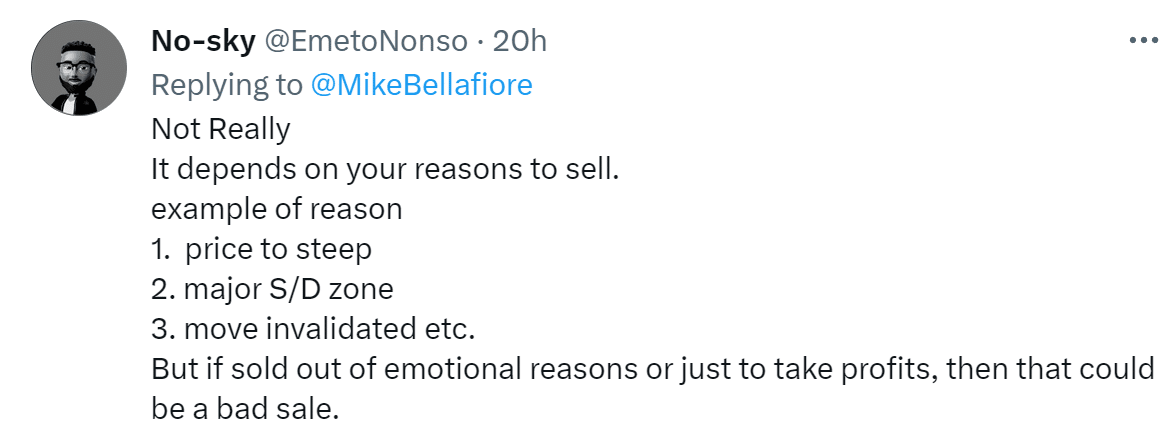
There is a trading problem traders sought to solve when I started trading. (We don’t have to mention when that was if that is okay with you).
There is a trading problem new traders needed to solve when we started our firm in 2005.
There is a trading problem some new traders on our desk need to solve today.
In fact, I just got an email from a very promising trader, where this was the very issue.
It is an age-old trading problem to solve for new traders. It is an age-old trading problem you MUST solve to become a Consistently Profitable Trader.
(5 Keys to Make More Money in Your Profitable Trades)
Let’s dive in.
The age-old trading problem
In a Daily Report Card, DRC, one of the newer traders we really love regretted that he cut a winning trade too early. He carped: “I covered WAY to early.” Here are his exact words from his DRC for you:
BITO – was talking through this with Arman, BTC made a really fast move in the past couple of days so looked for
the OE short, waited for the breakdown under VWAP and a pop to short then hit 1k vs VWAP. Threw some bids
and tbh I covered WAY to early in this but I was very uncomfortable in the trade as it was mid day and BTC wasn’t
moving very nicely. (no vol) made. Idea worked just needed to be more patient.
This is that age-old problem traders must solve. When do I exit my winning trades?
The trading frustration mounts
It can be very frustrating for new traders to exit a winning position BUT THEN watch it continue in the same direction. Traders lament how much money they left on the table.
They say and think:
- Argh… I should have just held this.
- If I could just hold my winners longer, I would be a Consistently Profitable Trader.
- Why I am just a wuss and scared to hold longer?
- What the heck is wrong with me?
There is nothing wrong with you. Well there may not be anything wrong with you. I mean we have never met. Maybe there is. But probably there isn’t. And understanding there is probably nothing wrong with you is important to recognize so you can solve the real problem.
There’s always a tweet
When I decide to write about a trading issue, I ask the trading community in a tweet for their thoughts. Transparently, my hope is to get the trading community thinking about this issue, contributing to the discussion, and learning from others. I am the son of a teacher so maybe this is where I get this from. And I did so on this very trading issue. I tweeted:

There are many excellent responses from our trading community here. This was a particularly good response from No-sky:

Develop clear trading rules to exit
From my seat, the issue is a lack of clear trading rules to exit your winning trades. The problem you must solve is how to exit your winning trades. And you must do this for every trade, for every type of trade. And each trade is different. Some trades are worth holding and you should lament exiting. Other trades, I would suggest, most trades for most traders, are perfectly fine to exit. And then what happens to the stock after does not matter.
And I know that is hard for new traders to wrap their heads around. You are thinking… But Bella if I sell and the stock trades higher, then I obviously made a mistake. I should have held. No. No. No.
Every trade has an exit that is right for that trade. And when that exit visits, then you exit. And what happens next has nothing to do with the execution of that prior trade. And after you exit, then you look for the next good trade that has its own clear exit rules.
That is why someone wrote in a book, which by the way I hear is very good, AND is called a “trading classic”, “One Good Trade. One Good Trade. One Good Trade.”
Let’s get back to that newer trader, who unearthed this age-old trading problem. I challenged this trader responding:
This is important to settle in your trading business.
Did you cover too early for your trading system? Or did the product just trade further after you exited?
Was this an issue of this trader exiting too early or false regret? Did this trader have that necessary set of rules to exit this trade for which he was regretful?
The newer trader’s response
The newer trader responded to my challenge. He responded definitively. He did so after thought and collaboration from a more experienced trader at the firm. He responded:
I full on covered too early. I was talking through this idea GChat w Arman and we both were looking at the gap fill and measured move and 2 day vwap as the target 15.20 (low 15 area) as a target. I didn’t stick to my plan and I got scared out of it. After the close I talked through it more with Arman. He told me that when there is a higher time frame setup aligning we need to be more conscious of the entry and exit as it might need some more wiggle room. If I am making a intraday swing trade I need to be prepared for the intraday swing trade not the scalp.
This a good response from the rookie. He reviewed this issue diligently and smartly with guidance from a more experienced trader.
(The #1 Reason the Failure Rate of Day Traders is So High (And what YOU can do about it)
Dynamic Risk Management
Further, exiting or holding is not an all or nothing decision. The rules you develop to exit are not sufficient if you only decide to completely exit or hold. It is also essential to consider a trade decision that takes partial profits. We call this dynamic risk management.
A Senior SMB Trader, better said a senior star SMB trader, copied on this DRC, offered invaluable insight to this newer trader on this very point. He mentored:
I think your own write up said more about the trade than you realize.
“I was very uncomfortable in the trade as it was mid day and BTC wasn’t moving very nicely.”
It seems like you had every reason to at least take a dynamic risk reduction (reducing risk because your idea is weaker than you initially perceived it to be, for instance because you now have more / newer information). And possibly to get out entirely. Oftentimes intuition can be an important consideration, especially for experienced traders.
I also agree with Bella’s point. You have to be clear about what your idea is, what your target is, and then just execute your system. Once your system says to do something, you do it, and what happens afterwards (such as you “could have” made more by holding on) is irrelevant.
Solution
- Develop clear exit rules for your winning positions.
- Create clear exit rules for all of the different types of trades in your PlayBook.
- Consider rules utilizing dynamic risk management.
- Continually measure and study your exits and consider exit adjustments.
- Adopt the mindset: One Good Trade. One Good Trade. One Good Trade.
From all of us at SMB, train and trade well.
Mike Bellafiore is the Co-Founder of SMB Capital, a proprietary trading desk, and SMB Training, which provides trading education in stocks, options, and futures. Bella, @MikeBellafiore, is the author of One Good Trade and The PlayBook. He welcomes your trading questions at [email protected]
